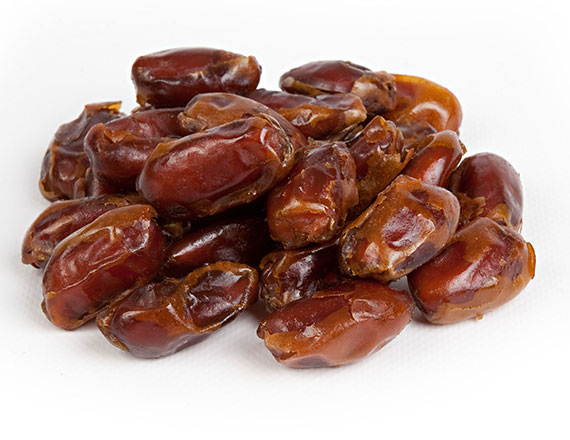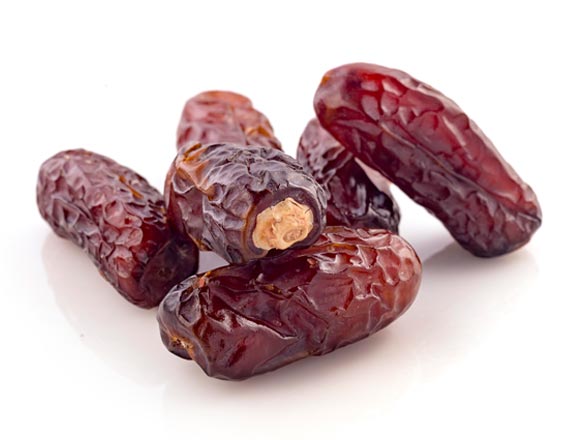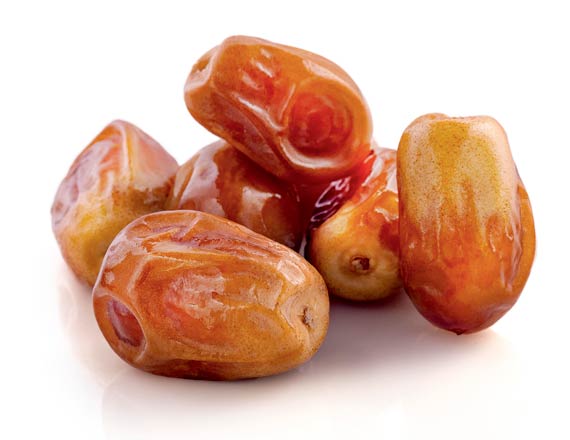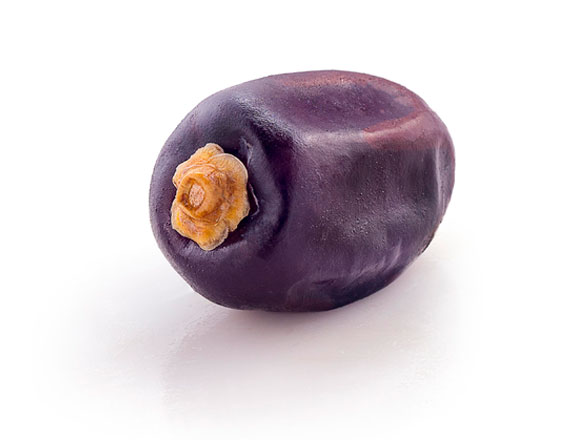|
Types of dates
About 400 varieties of dates are cultivated in Iran, but only some of them, mentioned bellow, because their tastes compose the major kinds.
|
Sayer Date: This semi-dried date grows in the khozestan region. The coloring of this kind is dark brown and it is purchased by many countries.
|
  |
|
Piarom Date (piyarom): This semi-dried grows in Hormozgan region. The coloring of this kind is dark brown and it has a unique taste. The skin of piarom date is thin. The piarom date has a kind of sugar which is acceptable for diabetic people.
|

 |
|
Zahedi Date: This dried date grows in Fars and Khozestan regions. The coloring of this variety is yellow. The zahedi date is used for industrial purpose because of its high sugar content.
|

 |
|
Kabkab Date: This fresh date grows in Fars regions. The coloring of this variety is black and its taste is very delicious.
|

 |
|
Mazafati Date: This fresh date grows in Kerman region. The coloring of this kind variety is black and its taste is very delicious.
|

 |
|
Other kinds such as rabbi and shahani are also available.
|
|
Date syrup
Date syrup is extract of carefully selected mature wholesome dates harvested exclusively in clean unpoluuted regions of the Middle East. The exact is concentrated to a total solid content of 70% by weight and contains no additives or preservatives. Indeed its high suger content(over 64%) acts as a natural preserving agent and, when protected from moisture and extraneous contaminants, the syrup has an almost indifinite shelf life.
The color of date syrup is dark brown, similar to that of the naturally matured fruit. This color is the result of the interaction of the proteins with the reducing sugars of the dates and is enhanced by the high temperture of the environment in which the dates mature. Color formation is accompained by the developmet of a characteristic flavor and aroma due to the physiological processes of maturation. It is this distinct flavor with its underlying pleasant sweetness that makes date fruit and its products, like date syrup, so attractive.
Direct consumption
Date syrup can be used instead of honey on bread or toast, instead of maple syrup on pancakes, as an ice cream topping, or for sweetening of coffe and tea.
Dairy products
Yogurt forget frays, daily rice, milk shakes and ice cream can all be sweetend and flavored with dates syrup to give attractive an refreshing products.
Jams and marmalades
Dates syrup can rep sugar, in part or completly, in jams and marmalades.
Baking
As a sweetener and flavoring for biscuits, fruit loaves, tart filling and similar products.
Sauces and relishes
Dates syrup blends well with a range of ingredients to give rise to a variety of sauces for snakes and main meals.
Soft drinks
Excellent sweetening and flavoring effects can be achieved when making drinks with lemon, lime, apricot and any other compatible fruit flavors.
Halwa
An original flavor is imparted to this Middle Eastern sweet when date syrup replaces portion of sugar or glucose syrup.
Confectionary
The syrup can be used as a binder and a sweetener for cereal and fruit bars and as an ingrediant instead of invert syrup or treacle for filled chocolate bars and related products. It could replace part of the sugar in toffee and fudge.
Energy substitute
One cup of warm milk, and three teaspoon of Lion Dates Syrup in the morning and evening. There is no other energy substitute than the date syrup in the world.
The history of the date
It is believed that the date palm originated from around the Persian Gulf, South Africa, or India, but researchers say that Iranians were the first nation to use the date as a food and for medicine purposes. The date palm is probably the oldest tree which has been cultivated in the world. Dates are divine fruit because they are mentioned in the KORAN and Jews believe that the date is one of the seven holy fruits in the world.
Botany of the date
Dates go through 4 stages of development:
1. Chimri, or Kimri, stage- the first 17 weeks after pollination: the dates are green, hard, bitter containing 80% moisture and 50% sugars (glucose and fructose) by dry weight.
2. Khalal stage- the next 6 weeks: the dates become full grown, still hard, the color changes to yellow, orange or red, the sugars increase and become largely sucrose.
3. Rutab stage- the next 4 weeks: the date are half-ripe, they soften, turn to light brown, and some sucrose reverts to reducing sugar which continues increase.
4. Tamar stage- the last 2 weeks: the dates become soft and their sugars are mostly reduced.
Loading capacity
|
Variety
|
Size
|
Capacity
|
|
Sayer
|
20 f
|
18 tons
|
|
Sayer
|
40 f
|
25-26 tons
|
|
Mazafati, Kabkab
|
20 f (refregerated container)
|
12-14 tons
|
|
Mazafati, Kabkab
|
40 f (refregerated container)
|
22-24 tons
|
|
Zahedi, Piarom
|
20 f
|
18-19 tons
|
|
Zahedi, Piarom
|
40 f
|
25-26 tons
|
Note: 1. Mazafati date needs refrigerated container.
2. We can accept 50% in advanced and rest confirmed L/C at 60 day by international bank.
Nutritional value of the date
100 grams of dried date has about 300 calories and is composed of about 70% carbohydrates, 2.2% protein, 0.6% fat while fresh dates contain about 160 calories.
|
Per 100g edible protein:
|
|
|
Potassium
|
650 mg
|
|
|
Calcium
|
64 mg
|
|
|
Phosphorus
|
63 mg
|
|
|
Magnesium
|
54 mg
|
|
|
Iron
|
3 mg
|
|
|
Niacin
|
1.6 mg
|
The uses of dates
Food uses: dates can be eaten plain or used for cooking in chopped form for cakes, sweet, pudding, bread, ice cream, cereal, candy. Surplus date is used in jam, jelly, juice, syrup, vinegar and alcohol.
Medicinal Uses: The fruit, because of its tannin content, can be used medically as a detersive and astringent for intestinal diseases. It can be used as infusion, decoction, syrup or paste and is administered as a treatment for sore throat, colds and bronchial catarrh. It is taken to relieve fever, cystisis, gonorrhea, edema and liver and abdominal diseases. It is also said to counteract alcohol intoxication.
|
.gif)
.gif)